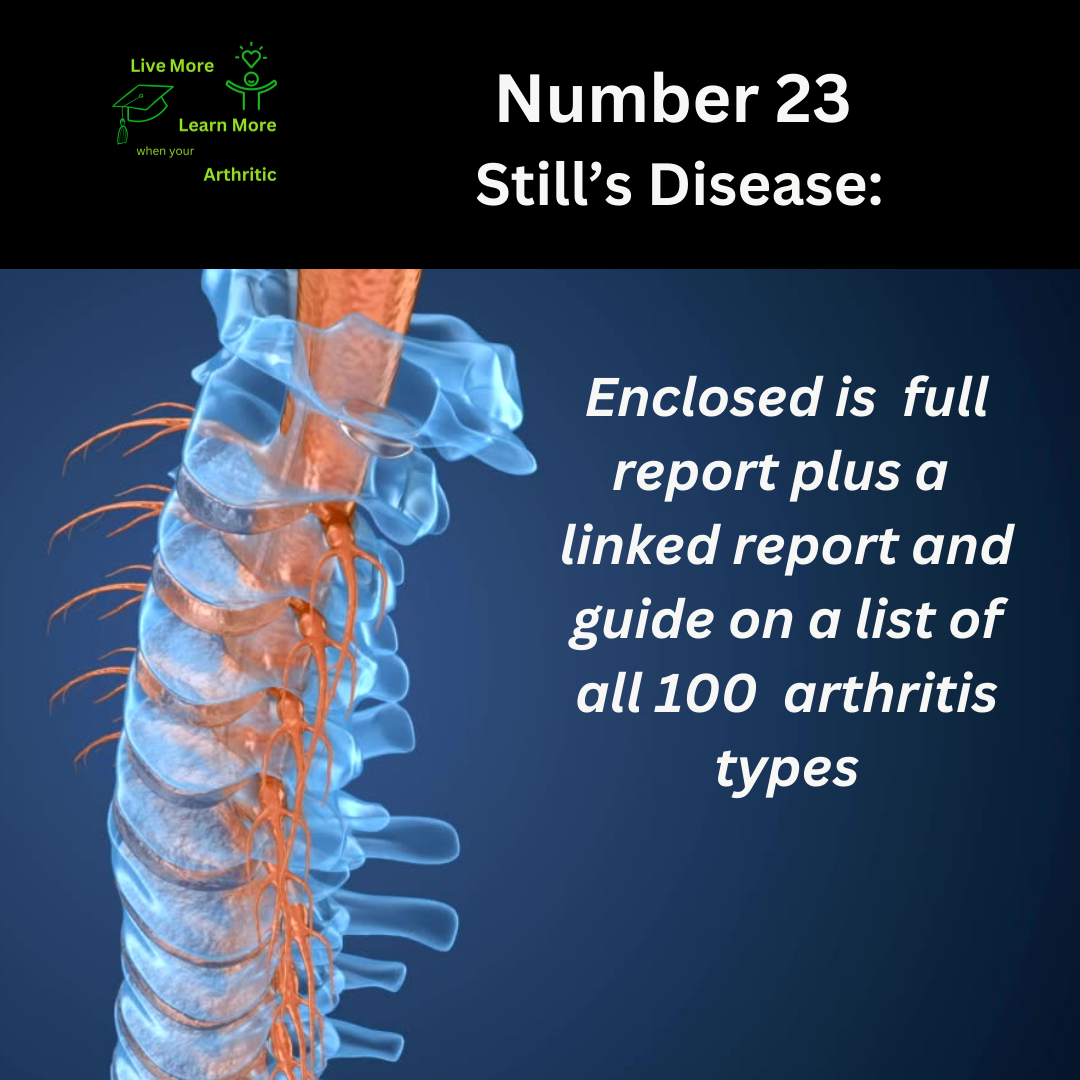
Still’s Disease: Number 23 on the list of 100 types of Arthritis
Understanding Still’s Disease: A Journey of Challenges and Triumphs
Still’s Disease, also known as Systemic-Onset Juvenile Idiopathic Arthritis (JIA), is a rare autoimmune condition characterized by inflammation throughout the body. While it primarily affects children, it can also occur in adults. This chronic condition presents unique challenges but can be managed effectively with proactive measures.
Still’s Disease involves chronic inflammation that affects joints, organs, and other tissues. The immune system mistakenly attacks healthy cells and tissues, leading to persistent inflammation. This inflammation can cause joint pain, fever, rash, and fatigue.
Causes
The exact cause of Still’s Disease remains unknown. However, it is believed to be an autoimmune disorder where the immune system mistakenly targets the body’s own tissues, triggering inflammation.
Triggers
Certain factors can trigger flare-ups in Still’s Disease. These may include infections, stress, or environmental factors. Identifying and managing triggers can help in minimizing disease activity.
Symptoms
Common symptoms of Still’s Disease include:
- Fever: Persistent high fevers that spike once or twice a day.
- Rash: Salmon-pink rash that often comes and goes with fevers.
- Joint Pain: Pain, stiffness, and swelling in the joints, especially in the morning or after periods of inactivity.
- Limited Range of Motion: Reduced ability to move joints fully due to inflammation.
- Fatigue: Persistent tiredness or lack of energy.
- General Malaise: Feeling unwell or sick.
Age of Onset
Still’s Disease often manifests between the ages of 2 and 5 years old. However, it can occur at any age, including adulthood.
Impact on Lifespan
With proper management, Still’s Disease does not necessarily shorten one’s lifespan. However, the condition can significantly impact quality of life.
Proactive Approach and Quality of Life
A proactive approach can greatly enhance the quality of life for individuals with Still’s Disease. This includes:
- Regular Exercise: Gentle exercises can help maintain joint flexibility and overall fitness.
- Healthy Diet: A balanced diet rich in anti-inflammatory foods can support overall health.
- Stress Management: Techniques like meditation or yoga can help reduce stress, which may trigger flare-ups.
Possible Complications
Complications of Still’s Disease may include:
- Joint Damage: Persistent inflammation can lead to joint damage and deformities over time.
- Growth Issues: In children, the condition may affect growth and development.
- Systemic Effects: Inflammation can impact organs such as the heart, lungs, or liver.
Holistic Breakthroughs and Health Advantages
While medication plays a significant role in managing Still’s Disease, holistic approaches can complement treatment. These may include:
- Acupuncture: Some individuals find relief from symptoms through acupuncture.
- Herbal Supplements: Certain herbal remedies may help reduce inflammation.
- Mind-Body Practices: Practices like tai chi or meditation can aid in managing symptoms.
Still’s Disease affects both males and females. In children, it tends to affect boys and girls equally. However, in adult-onset cases, women are more commonly affected.
Interconnected Diseases or Conditions
Individuals with Still’s Disease may be at higher risk of developing related conditions such as:
- Rheumatoid Arthritis: Similar autoimmune conditions may coexist.
- Inflammatory Bowel Disease: Conditions affecting the digestive system.
- Lymphoma: There may be a slightly increased risk of certain cancers.
Conclusion
Living with Still’s Disease requires a multidisciplinary approach involving medical care, lifestyle modifications, and emotional support. While the journey may have its challenges, many individuals with Still’s Disease lead fulfilling lives by managing their condition effectively.

